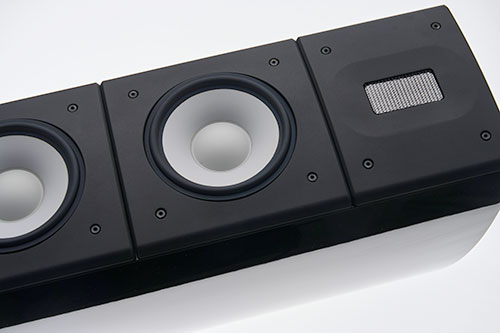This output stage is further linearized by the feedback loop of a discrete current feedback amplifier, which has a bandwidth of about 60 kilohertz at minus three decibels with open loop and almost one megahertz at minus three decibels with closed loop. The bandwidth of 60 kilohertz in the open feedback loop was achieved by a two-pole compensation method. This flattens the distortion in the audio spectrum as the open-loop gain drops off at higher frequencies compared to the typical Miller compensation. On the contrary, the large open-loop bandwidth mentioned does not exist in headphone amplifiers incorporating ICs.
In addition, the internal power supply is Hypsos' technological legacy. It features low-noise switching regulators with two-stage input and output filtering, followed by linear low-drop voltage regulators (LDO) with a fast transient response. For better channel separation, there are separate LDOs for both channels. Furthermore, the OOR features two DC inputs: a classic 2.5/5.5-millimeter DC jack plug and a 4-pin WEIPU plug, the same as on the Hypsos. To allow the use of the second option when purchasing a Hypsos, Ferrum includes with it a special power link cable with four-pin WEIPU connectors on both sides. When a normal cable is used, the "4-Terminal Sensing Design" (4TSD) feature in the Hypsos measures the voltage at the cable output, whereas with the FPL cable, the voltage is measured directly on the OOR’s main board. This allows the Hypsos to further stabilize the voltage in the current path.

There are eight independent main power rails in the OOR. For the amplifiers in the output stage, there are independent ±20 volt rails for both channels, based on low-noise, fast, linear low-drop voltage regulators. For the preamplifier stage, there are ±15-volt rails, also independent for both channels and based on linear LDOs. The ±20 volt rails of the LDOs are fed by switching converters that come up with two-stage filters at the input and output. The voltage at the output of the switching converters is approximately ±21.5 volts. Finally, there is an additional power rail just for the front LED, which is powered directly from the input power supply. The OOR features a six-layer circuit board. It has two layers just for the grounding surfaces. There are three groundings on the OOR: Signal ground, switching converter ground, and input power supply ground. These groundings and the power rails are separated by common mode chokes to further attenuate the high frequency common mode noise provenient from switching converters and the input power supply.

-
Raidho X2.6 Standlautsprecher
Mit Lautsprechern von Raidho haben wir uns bei Hifistatement schon öfter beschäftigt. Im Fokus standen dabei die Kompaktlautsprecher TD1.2 aus der TD-Serie sowie X1t und X1.6. aus der X-Serie. Diesmal haben wir den Standlautsprecher X2.6 zu Gast, das aktuell größte Modell der X-Serie. Raidho verspricht, mit der X-Serie besonders viel Leistung – sprich Klangqualität – für den aufgerufenen Preis zu bieten. Wobei, „billige“ Lautsprecher – ganz gleich nach welchem Maßstab - hat Raidho noch nie…02.12.2025 -
Canor Virtus A3
Zur diesjährigen HighEnd stellte Canor den Virtus A3 Hybrid-Vollverstärker vor. Der lockt mit einem integrierten Digital-Analog-Wandler und einer diskret aufgebauten Phono-Vorstufe für MM- und MC-Tonabnehmer. Sowohl seine Technik als auch die Ausstattung bieten Ungewöhnliches. Vor allem aber soll er klanglich beeindrucken. Das slowakische Entwickler-Team konnte mich bereits vor einem Jahr überzeugen: Der Vollverstärker Virtus I2 aus der Premium Line musizierte in meinem Hörraum wie keiner zuvor in dieser Preisklasse. Der war ein gestandener Röhren-Vollverstärker. Auch…28.11.2025 -
Dan D’Agostino Progression S350
Dan D’Agostino ist eine Legende im Verstärkerbau. Er folgte wohl nie einer Mode, sondern vertraut bei allen Entwicklungen seinem Gehör und seiner Leidenschaft für den guten Klang. Mehr als 50 Jahre baut er nun schon Verstärker, immer mit dem Ziel, das „Wesen der Musik hörbar zu machen“. Erfüllt auch der S350 diese hoch gesteckten Ambitionen? Die Progression S350 ist die kleinste Stereoendstufe im Gesamtprogramm. Optisch trägt sie alle charakteristischen Merkmale einer echten D’Agostino. Angefangen mit…25.11.2025 -
iFi Silent Power USB iPurifier Pro & Pulsar USB
Ohne iFis iDefender+ würde das PC-Audio-Setup in meinem Arbeitszimmer überhaupt nicht störungsfrei funktionieren. Dementsprechend ist es für mich eines der besten Tools im Bereich Computer-Audio. Der iPurifier Pro vereint seine Fähigkeiten mit denen eines iSilencer+ und noch mehr Features in einem Gehäuse. Außerdem teste ich das Pulsar USB-Kabel. iFi ist seit Jahren eine Konstante für hochqualitative Audio-Produkte zu fairen Preisen. Zuletzt wurde die Sparte für Stromversorgung, Kabel und Signal-Verbesserer unter SilentPower zusammengefasst. Noch bevor wir…21.11.2025 -
Eversolo T8
Der Eversolo T8 ist als Streaming-Transport ein neuer Baustein einer Konzeption, die auf Trennung der digitalen Komponenten setzt. Dennoch ist er nicht allein für Perfektionisten konzipiert, sondern bietet sogar Einsteigern vielfältige und sinnvolle Möglichkeiten. Die bislang allerorts hochgelobten Eversolo Streamer besitzen integrierte Digital/Analog-Wandler, sind teils auch als Vorverstärker nutzbar oder wie der Eversolo Play sogar als all-in-one Streamer, DAC und Vollverstärker. Mit dem T8 eröffnet Eversolo auf den ersten Blick eine neue anspruchsvolle Produktreihe, in…18.11.2025 -
Chord Huei
Auf kompromisslos Weise transferiert Chord Electronics sein digitales Know-how in die analoge Welt und präsentiert uns den kompakten Phono-Vorverstärker Huei. Das massive Aluminiumgehäuse beherbergt moderne SMD-Technik auf kleinstem Raum, womit die Briten den Beweis antreten wollen, dass Vinylgenuss kein großes Gehäuse braucht. Jetzt mal ehrlich, dieses ganze Hifi-Zeugs nimmt doch ohnehin schon genug Platz im Wohnzimmer ein und ich persönlich bin dankbar für jedes Gerät, dass ein wenig sparsamer mit dem auf dem Rack verfügbaren…11.11.2025
© 2025 | HIFISTATEMENT | netmagazine | Alle Rechte vorbehalten | Impressum | Datenschutz

























 |
|




















































































